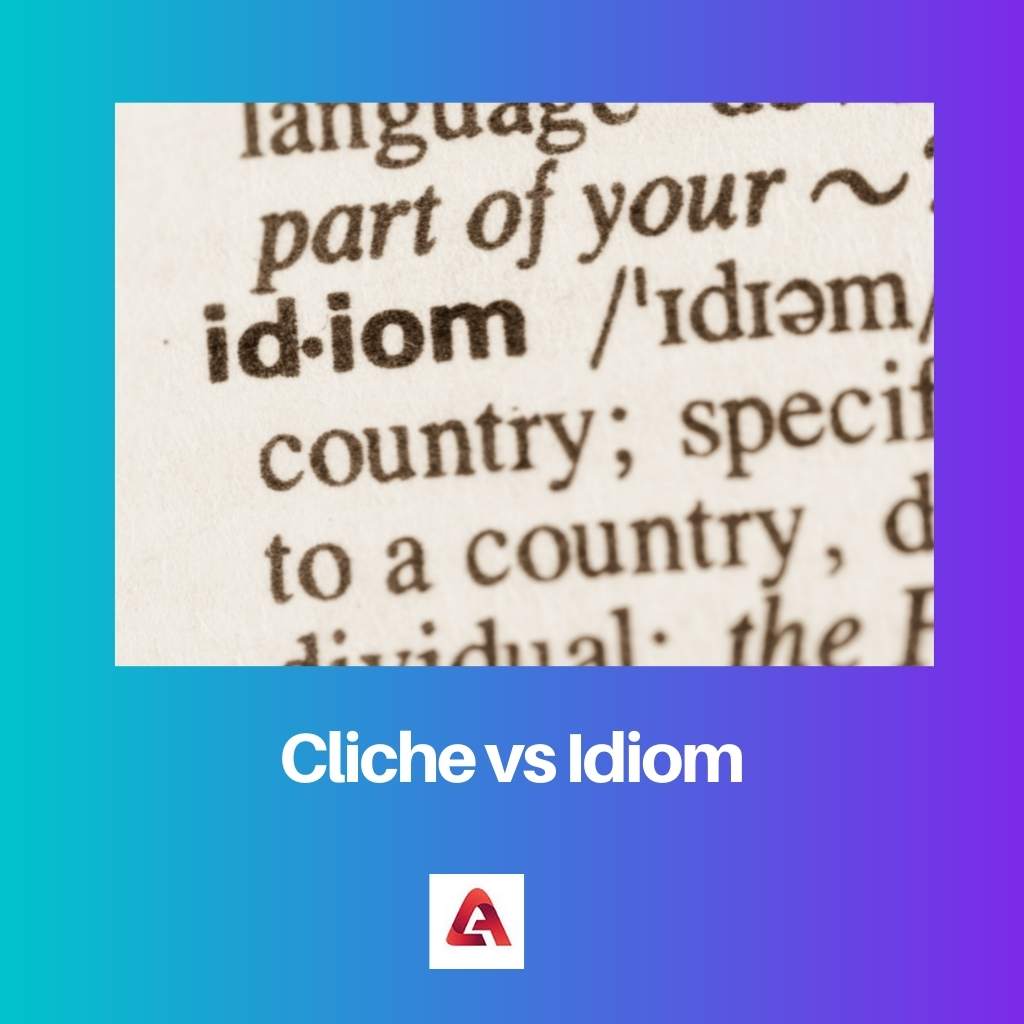English is the most commonly spoken language in every country. It has different structures, phrases, idioms, and one-word substitutions that increase the standard of speakers.
Idioms and clichés are idiomatic expressions with fixed meanings that differ from each other. They are used in spoken and written English but in different contexts and levels.
Key Takeaways
- Cliché refers to an overused phrase or expression that has lost its original meaning and impact over time. An idiom is a group of words whose meaning cannot be inferred from the literal definition of its words.
- While cliches are avoided in writing or speech, idioms are frequently used to convey a specific idea or sentiment creatively and memorably.
- Cliches are criticized for being trite and unoriginal, whereas idioms are celebrated for enhancing communication and adding color to language.
Cliche vs Idiom
A cliché is an overused expression or idea that has lost its originality and impact, while an idiom is a phrase whose figurative meaning differs from its literal interpretation. Although both clichés and idioms can enrich the language, clichés may appear trite, whereas idioms convey unique cultural insights.

Cliches are idioms but lost their importance because of overuse in daily conversation. Cliches come in figurative and literal forms, which are some meanings of cliches that can be understood easily.
Cliches are boring and are avoided in professional writing. Any idiom that is used more than it has to become clichés, but cliches do not become idioms.
Idioms are phrases that are formed by combining two or more words to appear with different meanings. The meaning of the idioms does not relate to the sense of individual terms used in the phrases. They are non-literal, and hard to understand the purpose unless it is used with the context.
Comparison Table
| Parameters of Comparison | Cliche | Idiom |
|---|---|---|
| Definition | Cliches are idioms that have literal and figurative meanings to the group of words. | An idiom is a phrase that has a fixed meaning to a group of words. |
| Usage | Cliches are used in regular conversations. | Idioms are rarely used in conversations. |
| Freshness | IT lacks freshness and importance. | It gives freshness in the context. |
| Writing | It is recommended to avoid cliches in professional writings. | Idioms increase the level of writings. |
| Positivity | It gives a negative understanding in the sentence. | It adds positive sense to the sentence. |
What is Cliche?
Unknowingly, many of us use idioms in daily conversations such as ‘ a piece of cake, hold your horses, and others that lost their importance are called clichés.
Cliches are idiomatic expressions that have lost their meaning because of overuse in daily conversations. Cliches do not have a self-sufficient purpose and add sense based on context usage.
These are used in everyday conversations and are unacceptable in professional communications and writing.
Types of cliches
- Figurative cliches: these clichés do not have meaning when they are translated into another language. Only those who have command of idiomatic expressions can understand the meaning.
- Literal cliches: they have independent meanings. These are easily understandable by everyone.
Cliches
As a duck takes to water– it is used to say some have learned something easily and naturally.
Ex: she started swimming and learned quickly as a duck takes to water.
Better late than never– it is used to indicate something to do late is better than not doing.
Ex: it took me two years to complete reading my holy book, but better late than never.
Clear as Crystal is used to indicate something that is easy to understand, transparent and plain.
Ex: the lecturer explained programming as clearly as crystal.
Dry as dust– it is used to indicate dull, boring things.
Ex: the movie is dry as dust as the actors.

What is Idiom?
The English language has different sentence structures, phrases, one-word substitutions, idioms, and clichés that increase the quality of writing. It is a demanding language to learn as it has many rules to remember.
One such concept is the idioms that have to be remembered to use it accurately and in the proper context because these phrases have fixed meanings.
Idioms are expressions with non-literal meaning; that is, the import of individual words contributes to the sense of the whole phrase. The idioms are difficult to understand and have different meanings in different languages.
Types of idioms
- Opaque idioms: the meaning of the idioms is not easily understandable.
- Transparent idioms: the meaning of the phrase is understandable based on the context.
Idioms
All wool and a yard wide– it is used to express the high qualities of someone or something.
Ex: the software has bugs; it’s not all wool and a yard.
Every messenger of God is all wool and a yard wide.
Back to the drawing board– it is used to indicate the start from scratch again.
Ex: The project team has to go back to the drawing board as the software fails to produce the expected output.
Down the tubes– it is used to indicate waste, failure, and defeat.
Ex: His career went down the tubes when he got caught red-handed for consuming drugs.
Down-to-earth– it is used to indicate the frankness, honesty, and practical approach of someone or something.
Ex: the service provider is very down-to-earth; he told every detail of services.
Lisa is a down-to-earth girl on the whole campus.

Main Differences Between Cliche and Idiom
- Idioms are phrases with fixed meanings and can only be understood by professional speakers. Clichés are phrases that have both fixed and literal meanings that can be understood by anyone based on the context usage.
- Idioms are rarely used in daily conversations, but clichés are used in everyday conversations.
- Idioms add freshness to the sentence, while the clichés lack freshness due to over-usage.
- Idioms are used in professional writing, and clichés are eluded in professional transcribing.
- Idioms give a positive sense, whereas clichés give a negative understanding in conversation.

The explanation of idioms and their types is enlightening. It’s interesting to see the intricacies of these phrases that are so integral to language.
It’s fascinating how idioms and clichés play a role in language. I’m particularly interested in the types and usage of cliches and idioms. Thanks for sharing this insightful information.
I agree, Greg. Understanding the nuances of cliches and idioms can greatly improve one’s language skills.
The comparison table is very helpful in understanding the differences between cliches and idioms. It’s important to know when to use each in different contexts.
I found the types of cliches and idioms particularly insightful. It’s interesting to see the variety within each category.
I completely agree, Donna. The examples provided also help illustrate the concepts clearly.
The examples of idioms and their meanings highlight the richness and complexity of the English language. This article offers valuable insights into idiomatic expressions.
Absolutely, Noah. Understanding the nuances of idioms is crucial for effective communication.
This article provides a thorough understanding of cliches and idioms. The comparisons and examples offer a comprehensive insight into these important language elements.
I appreciate the clear breakdown of cliches and idioms. This distinction is crucial for effective communication in English.
The examples of cliches and idioms provided make it easier to grasp their meanings. This article is a valuable resource for understanding language nuances.
Interesting comparison between cliches and idioms in the English language. It’s important to understand the differences between the two in order to use them effectively in communication.
The categorization of cliches and idioms based on their meanings and usage is incredibly valuable. It helps in recognizing and applying them effectively in communication.
I completely agree, Millie. This article provides a comprehensive understanding of idiomatic expressions.
I found the breakdown of cliches and idioms to be very informative. It’s essential knowledge for anyone looking to improve their language skills.
The breakdown of figurative and literal cliches, as well as opaque and transparent idioms, is very informative. It’s important to be aware of these distinctions in language.
Absolutely, Alison. Being able to recognize these distinctions can significantly enhance one’s comprehension of idiomatic expressions.
I agree, Alison. This article provides a comprehensive understanding of the complexities within cliches and idioms.